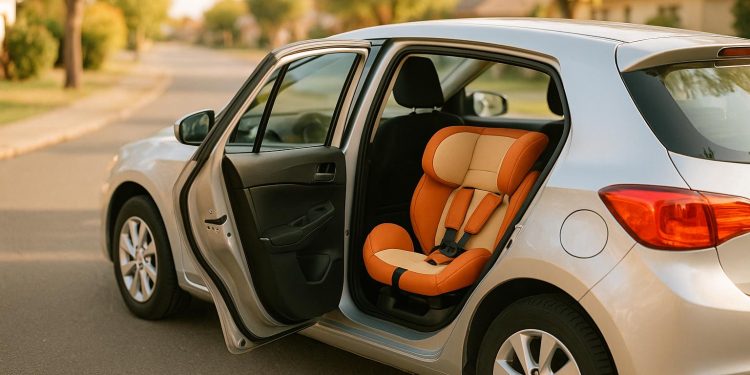South Africa’s child car seat laws are designed to protect young passengers based on age, weight, and height. Drivers are legally required to use appropriate car seats or booster seats to ensure children’s safety. These regulations aim to reduce injuries and fatalities caused by car accidents, which are a major risk for children.
Here’s what you need to know:
- Rear-facing seats: For infants and young toddlers, offering critical head, neck, and spine protection.
- Forward-facing seats: For toddlers who outgrow rear-facing seats, equipped with harnesses for added security.
- Booster seats: For older children, ensuring proper seat belt positioning until the belt fits securely.
Drivers are responsible for compliance, and violations can lead to fines. Always choose certified car seats, follow installation instructions, and upgrade as your child grows. Ensuring proper use of car seats is crucial for safety.
Legal Requirements for Child Car Seats
In South Africa, regulations stress the need for proper child restraint systems to ensure the safety of young passengers. While specific thresholds might not always be outlined, it’s mandatory for children to use car seats or boosters that are correctly sized for their age, height, and weight. For the most accurate and current information, always refer to local authorities or official resources.
Age, Height, and Weight Guidelines
As children grow, their car seat needs change. The general recommendation is to transition from rear-facing seats to forward-facing seats, and eventually to booster seats. These shifts should align with your child’s size and weight. Staying informed about the latest safety recommendations is crucial to ensure your child remains protected.
Vehicle Types and Responsibilities
In private vehicles, securing child passengers is not just a recommendation – it’s a requirement. Drivers are responsible for ensuring that all child passengers are properly restrained at all times.
Certified Safety Standards for Car Seats
When selecting a car seat, make sure it complies with recognized safety standards and is certified by local regulatory authorities. This ensures the seat has undergone rigorous testing to meet safety benchmarks.
Age and Size Guidelines for Child Restraints
Choosing the right car seat depends on a child’s age, weight, and height. Each type of car seat is designed for specific stages of a child’s growth. Infants typically begin with a rear-facing car seat, and transitions to other types should always follow the manufacturer’s guidelines. Be sure to check your car seat manual and local regulations for exact requirements. Here’s a closer look at the different types of restraints and their usage.
Rear-Facing Seats for Infants
Rear-facing car seats are essential for protecting an infant’s head, neck, and spine by evenly distributing crash forces. Always adhere to the weight and height limits provided by the seat’s manufacturer. Importantly, never place a rear-facing seat in the front passenger seat if the vehicle has an active airbag – it poses a significant safety risk.
Forward-Facing Seats for Toddlers
When a child outgrows the weight or height limits of their rear-facing seat, it’s time to switch to a forward-facing car seat with a harness. These seats are designed to spread crash forces over the stronger parts of a toddler’s body. Ensure the harness fits snugly across the shoulders and chest for maximum safety. As with rear-facing seats, follow the manufacturer’s instructions to know when it’s appropriate to transition.
Booster Seats for Older Children
Booster seats help position a vehicle’s seat belt correctly on a child’s body, ensuring the lap belt sits low on the hips and the shoulder belt crosses the chest. Transitioning to a booster seat should be based on the manufacturer’s recommendations and once the child’s size allows the seat belt to fit properly. Even after moving to a booster seat, safety experts recommend that children under 13 continue to ride in the back seat, which is widely considered the safest spot in the vehicle. These practices align with South Africa’s legal standards for child restraints.
For a quick overview, refer to the table below:
| Car Seat Type | Suitable Age Group | Key Features and Guidelines |
|---|---|---|
| Rear-Facing | Infants and young toddlers | Provides critical support; follow weight and height limits |
| Forward-Facing | Toddlers | Includes a secure harness; adjust as the child grows |
| Booster Seat | Older children after outgrowing forward-facing seats | Ensures proper seat belt fit; use until the belt fits securely |
Penalties for Breaking the Law
Failing to comply with South Africa’s child car seat regulations can lead to fines and other legal consequences. Following these rules not only helps you avoid penalties but also plays a crucial role in keeping everyone on the road safer.
Fines and Legal Consequences
If you’re caught violating child restraint laws, you can expect to face monetary fines. These regulations are strictly enforced to emphasize the importance of road safety and to protect young passengers.
Driver Responsibility and Insurance Impact
The responsibility for ensuring child passengers are safely secured lies entirely with the driver. Even small mistakes can lead to legal issues, and in some cases, may affect your insurance. Staying vigilant and following the rules is essential to avoid complications and ensure the safety of all child passengers.
sbb-itb-09752ea
How to Choose and Install Child Car Seats
Picking the right car seat and installing it correctly are key steps to keeping your child safe while traveling. Always refer to the car seat’s manual and follow local safety regulations to make informed decisions.
Selecting the Right Car Seat
Choose a car seat that matches your child’s height, weight, and age, and ensure it meets local South African safety standards. It’s also important to check that the seat fits securely in your car. Look for car seats with official safety certifications to ensure reliability.
Once you’ve selected the right seat, the next step is proper installation.
Installation and Daily Use
Installing the car seat correctly is just as important as choosing the right one. Carefully follow the instructions in the manual. Whether you’re using a seat belt or another anchoring system, make sure the seat is secured tightly and doesn’t move around. After long trips or minor bumps, double-check the installation to ensure it remains secure.
Regular Checks and Upgrading
Inspect the car seat regularly for any signs of wear or damage. As your child grows, follow the manufacturer’s recommendations to upgrade to a seat that fits their new size and weight requirements.
Conclusion
Ensuring the safety of children in vehicles is one of the most important responsibilities for any driver. Using the right child restraint systems plays a crucial role in safeguarding young passengers and minimizing risks during travel.
Always adhere to legal requirements and carefully follow manufacturer instructions when selecting, installing, or upgrading car seats. Taking these steps ensures your child’s protection stays a top priority.
FAQs
What happens if I don’t follow child car seat laws in South Africa?
Failing to follow South Africa’s child car seat laws can lead to fines or other penalties. If you’re caught without an appropriate car seat for a child who falls under the required age, height, or weight, authorities may issue a monetary fine. In cases of repeated violations or serious non-compliance, the consequences could become more severe.
To keep your child safe and avoid these penalties, always use a car seat that aligns with legal standards and fits your child’s size and age. Understanding and adhering to these laws not only protect your family but also contribute to safer roads for everyone.
How do I know if a car seat complies with South African safety regulations?
To ensure a car seat complies with South African safety regulations, check for approval under United Nations Regulation ECE R44/04 or R129. You’ll find a certification label on the seat that confirms it meets these legal standards. It’s also essential to select a seat that suits your child’s age, weight, and height, as required by South African law.
When buying a car seat, stick to trusted retailers. Avoid second-hand options unless you’re absolutely sure about their history and condition. For your child’s safety, always install and use the seat according to the manufacturer’s instructions.
When should I switch my child from a forward-facing car seat to a booster seat?
The right moment to switch your child from a forward-facing car seat to a booster seat depends on their weight, height, and age. In South Africa, it’s recommended that children stay in a forward-facing car seat with a harness until they exceed the height or weight limits set by the manufacturer.
This transition usually occurs between the ages of 4 and 7, but it’s essential to follow the specific instructions for your car seat model. When moving to a booster seat, make sure your child can sit properly, with the seat belt positioned securely across their chest and lap – never on their neck or stomach. Ensuring the seat belt fits correctly is key to keeping them safe on the road.
Related Blog Posts
- Age-Based Import Taxes for Used Cars in South Africa
- South Africa’s Vehicle Import Tariffs Explained
- Where to buy safe used cars in South Africa
- Ride-sharing Regulations in South Africa: What You Need to Know





